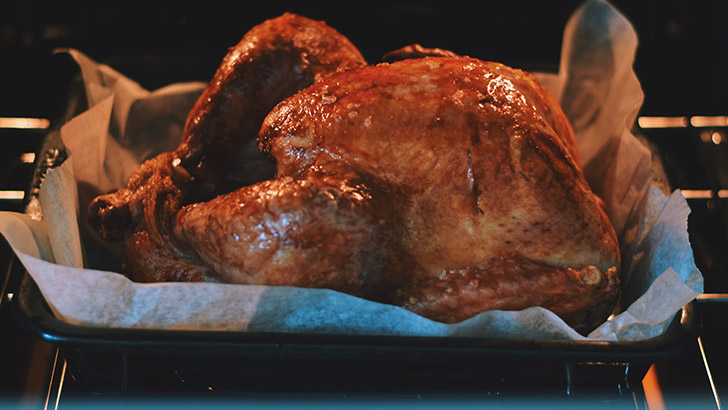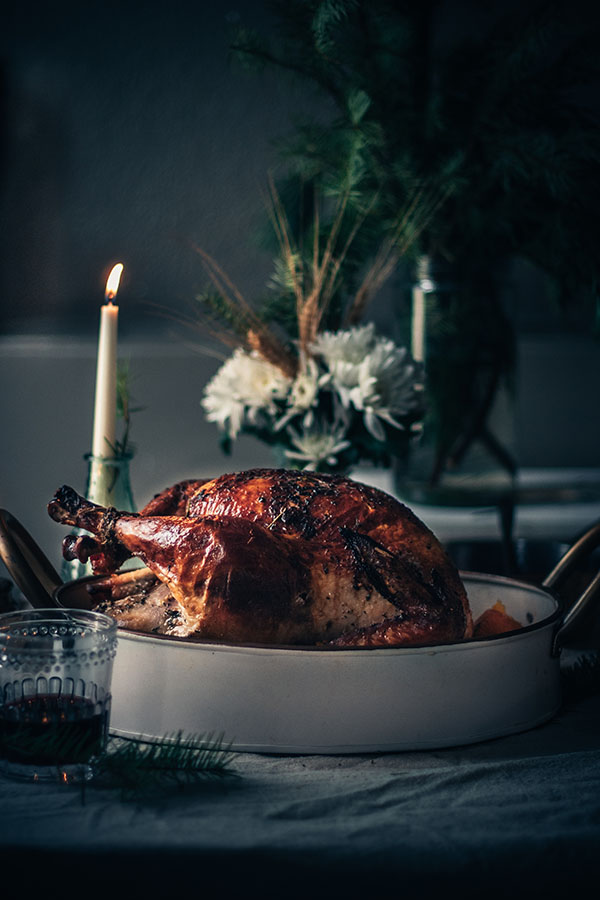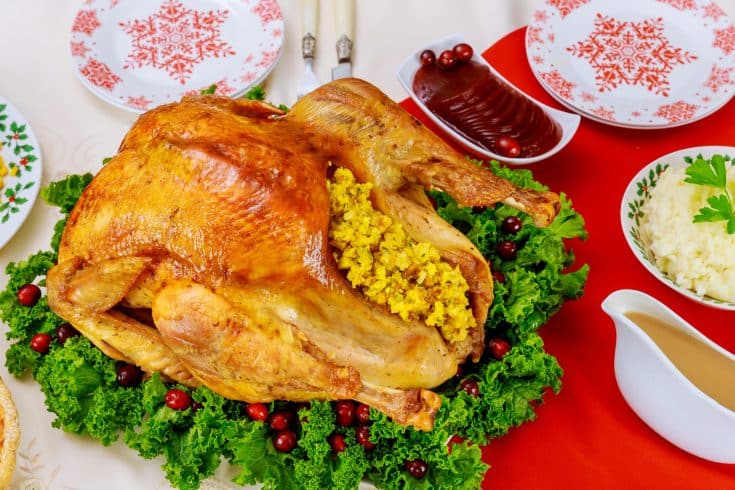Updated on November 20th, 2023
If you’re wondering how long to
Here are some of the answers you’ll find in this cooking turkey guide.
- What is the cooked temperature for a whole turkey?
- Where to insert the meat thermometer in a turkey?
- How many pounds of turkey do I need?
- What is turkey’s cook time per pound?
- What about cooking a stuffed turkey?
- How long to cook a 20-lb turkey? / How long to cook an 18-lb turkey? / How long to cook a 16-lb turkey? / How long to cook at 14-lb turkey? / How long to cook a 12-lb turkey?
- How long should the turkey rest before carving?
- How to season a turkey before cooking?
If you already plan on roasting the turkey, you might also see my step-by-step guide to roasting turkey in the oven.

The target internal temperature for turkey
What is the cooked temperature for a whole turkey? The USDA recommends a minimum internal temperature of 165°F or 74°C. Note that the turkey’s innermost breast meat might be 165°F (74°C), while the wing and thigh will be higher — around 175°F (79°C) or 180°F (82°C).
How do I check my turkey’s temperature while it’s cooking? Knowing the target internal temperature is only half the battle. The other, harder half is measuring your turkey’s temperature while it cooks. You have three options here: Buy a turkey with a pop-up timer, use an external thermometer, or lean on both methods.
Pop-up turkey timers
A pop-up turkey timer is a plastic device that’s already inside the turkey when you buy it. Confession time: The first time I bought a turkey with a pop-up timer, I didn’t know what the plastic thing was. I tried to remove it, thinking I shouldn’t cook the
In any case, if your turkey has a white prod with a colored top inserted near the wing or breast, that’s your pop-up timer. When the turkey is done, the colored top pops up.
Pop-up timers are handy and I’ve had good luck with them. Still, you should know that a Consumer Reports study concludes that these timers can pop before your turkey is fully cooked. So, validate the pop-up timer with an external thermometer.
Meat thermometer
Food thermometers can be tricky to use. You have to insert the thermometer in the right place to get a good reading, for one. A bigger problem is that some thermometers aren’t very accurate. If you don’t trust the temperature reading, there’s no way to know when your turkey is done.
I’ve tried many thermometers. In my experience, most of them seem to work fine at the beginning and then fail after a few uses. The only one I’ve found that keeps working is Thermapen. This is a digital, instant read thermometer — which means you don’t leave it in the bird while it cooks. You just pop it in periodically to check the temperature.
Thermapen retails for $79. It’s a lot, I know. There are cheaper Thermapen knock-offs available on Amazon. I can’t vouch for them, but they may be worth trying if you’re on a budget.
Where to insert the thermometer in a turkey? It’s common to place the thermometer deep in the breast horizontally, starting near the neck cavity. The USDA recommends checking the temperature in three places, however. So start with the breast. Then check the wing and the deepest part of the thigh. If any of the readings are below 165°F or 74°C, let it continue to cook.
The size of the bird
Know that bigger turkeys take longer to cook. You can roast a 6-lb. turkey breast in a couple hours, while a 24-lb. bird will need up to 5 hours to cook. See turkey cook times below for more information.
How much turkey do I need? Assuming you will buy a entire turkey, and not just the breast or legs, you’ll need about 1 pound of turkey per person. So if you’re expecting 10 guests, a 10-pound turkey should suffice. If you want leftovers, or plan to serve larger portions, then aim for 1.5 pounds per person. That equates to a 15-lb turkey for 10 people.
Best oven temperature for roasting turkey
Roasting low and slow at 325°F or 163°C is the recommended way to cook the best Thanksgiving turkey. At 325 degrees, you will roast an unstuffed turkey in the oven for 15 minutes per pound of meat.
How long to cook a turkey per pound
How long it takes to
- 325°F or 163°C: 15-20 minutes per pound
- 350°F or 177°C: 13-14 minutes per pound
- 375°F or 191°C: 10-12 minutes per pound
- 400°F or 204°C: 9-10 minutes per pound
Know that the higher the oven temperature, the greater risk you have of overcooking and drying out your turkey.
If you haven’t already shopped for your turkey meal and you want something that cooks fast, try oven-roasting a turkey breast instead. Turkey breast is easier to prepare and roasts much faster than a whole bird. See how to roast a turkey breast here.
How long to roast a turkey by total weight
Below are approximate turkey roasting times based on total weight of the bird. These times assume you are roasting the turkey in your oven at 325°F or 163°C, without basting. Check for doneness with a meat thermometer at least 30 minutes short of the times shown below, or use a leave-in thermometer.
Here’s your turkey cooking time chart:
- Cook a 20-lb turkey at 325°F/163°C for about 5 hours.
- Cook an 18-lb turkey at 325°F/163°C for about 4 1/2 hours.
- Cook a 16-lb turkey at 325°F/163°C for about 4 hours.
- Cook at 14-lb turkey at 325°F/163°C for about 3 1/2 hours.
- Cook at 12-lb turkey at 325°F/163°C for about 3 hours.
How long to roast turkey in an oven bag
Roasting your turkey in an oven bag can deliver a juicy turkey with less mess. The oven bag method also shortens your cooking time. The juices trapped in the bag keeps the turkey moist so you can roast it at a hotter temperature, faster.
To roast your turkey for Thanksgiving in a bag, use these approximate cook times with your oven set at 350°F or 177°C.
- 12- to 16-lb turkey in an oven bag: 2 to 2 1/4 hours
- 16- to 20-lb turkey in an oven bag: 2 1/4 to 2 1/2 hours
- 20- to 24-lb turkey in an oven bag: 2 1/2 to 3 hours
To prepare the oven bag with flour, add 1 tablespoon of flour to the bag and shake it well. Place the bag in a roasting pan and add the celery, onion, and carrots to the oven bag.
Place your seasoned turkey on top of the vegetable layer. Close the oven bag and cut 6 holes over the top of the oven bag to allow steam to escape, then tuck the ends of the oven bag into the pan.
Now you’re reading to start roasting the turkey. Pop it in the oven and bake until the thickest part of the breast registers 165°F or 74°C.
How long to prepare turkey in the crockpot
If you have a smaller turkey that’s 8 or 10 pounds, you can put the whole bird into a crockpot. The cook time will be 6 or 7 hours on low heat. Rest the turkey for 20 minutes before carving. Optionally, you can then broil it for 5 minutes for crispy skin.
9 turkey prep cheats

Knowing the right cook time is only part of preparing a delicious turkey. Here are a few more tips about thawing, brining, seasoning, basting, and carving your bird.
1. How to thaw a turkey
The safest way to thaw a frozen turkey is in the refrigerator. This is not an overnight project, however. Refrigerator thawing takes several days. Assume 1 day for every 5 pounds of turkey.
If you need to thaw your turkey faster, use the cold water method. Leave your turkey in its packaging and dunk the whole bird into cold water. You might have to put a weight on top to hold it under water. Change out the water every 30 minutes or so.
Can you thaw a turkey in the microwave? Yes, you can thaw a turkey in the microwave — if it will fit. Use the defrost setting on the microwave that sets cook time according to weight. Rotate, turn, and flip the turkey several times as it defrosts. With this method, you do risk defrosting the bird unevenly or cooking it slightly in the microwave.
2. Brining your turkey
Brining is not required, but it does result in a juicier, more flavorful bird. Note that the benefits of brining are negligible if you’re going to roast the bird in an oven bag.
You can make a simple turkey brine by mixing 1 cup of sugar and 1 cup of salt into a gallon of water. Unwrap your turkey, remove the giblets, and submerge the whole bird into the brine. Let the bird soak in the refrigerator overnight.
If you don’t want to mess with a liquid brine, you could also salt the turkey inside and out the day before you cook it.
3. About stuffing your turkey
You might be wondering how stuffing your turkey affects the cook time. Here’s my advice: Leave your turkey unstuffed. It’s too hard to know if every bit of stuffing inside the turkey has reached the minimum 165°F or 74°C temperature. It’s easier and safer to cook stuffing in a separate dish, outside the turkey.
If you must stuff the turkey, extend the time the turkey roasts and check the temperature in several places before you allow your turkey to rest.
4. Seasoning your turkey
The basic formula for seasoning a turkey is simple. Combine a fat with your favorite seasonings and rub them all over the bird. Softened butter adds delicious flavor, but any oil would work also.
To take your roasted turkey to the next level, gently loosen the skin and carefully rub butter and your seasonings under the skin, too. You can pop some quartered onions and fresh herbs inside the bird’s cavity.
5. Elevating the turkey (you don’t need a rack!)
You will want to elevate the turkey so it doesn’t cook unevenly or get soggy on the bottom. You can do easily accomplish this by using a roasting rack. If you don’t have a roasting rack, load up the bottom of your baking dish with chopped vegetables and place the turkey on that. (You could also roll up foil and set the turkey atop some oven-safe utensils. But the veggie option produces a more flavorful turkey, so I’d go with that.)
6. Breast side up or down?
There are folks who recommend roasting a whole turkey with the breast side facing down, then flipping it over halfway through. I don’t love this method, because you risk dropping the bird when you try to flip it. You can get similar results by using the foil method described below.
7. Covering the turkey
Basting adds nice flavor to the skin, but it can alter the cooking time. Every time you open the oven door to baste, the temperature will dip slightly. I recommend not basting, because those tiny temperature changes can affect your end result.
8. Resting your turkey
After you remove the turkey from the oven, rest the turkey for 30 minutes after cooking and before carving. During this time, the meat reabsorbs the juices that were released during cooking.
9. Carving a turkey
Carving a turkey is like carving a huge chicken: Pull out the joints that hold the wings and thighs to the bird and cut straight through them. The rule of thumb is to remove the wings first, then the thighs. You can split the thighs into thighs and drumsticks once the meat has been removed.
Carve through the breast in slices, from the outside in.
And that’s it! Your complete guide for how long to
Oven-roasted Whole Turkey

Ingredients
- 1 whole turkey, thawed
- 2 to 3 medium-sized onions
- 3 celery ribs
- 4 to 5 medium-sized/baby carrots
- ½ tbsp of nutmeg
- 1-2 Tbsp of sea salt
- 1-2 Tbsp of black pepper
- 1 Tbsp of ground ginger
- 1 Tbsp of garlic or onion powder
- Unsalted butter, softened
- 2 Tbsp of vegetable oil
- Potatoes
Instructions
- Thaw your turkey in the refrigerator. This can take 1 day for every 5 pounds of turkey. That's 3 days for a 15-lb turkey. Start an extra day early if you plan to brine your turkey.
- Remove giblets.
- Optionally, mix 1 cup of salt and 1 cup of sugar into 1 gallon of water. Submerge the turkey in the water and refrigerate overnight.
- Preheat your oven to 325F.
- Pat your turkey dry.
- Mix softened butter with your seasonings.
- Cut your vegetables into bite-size chunks.
- Rub the butter seasoning mix all over the turkey, inside and out. Gently loosen the skin on the breast and use your fingers to smear the seasoned butter under the skin. Take care not to tear the skin.
- Place your vegetables in the bottom of your roasting pan.
- Place a roasting rack in the pan above the vegetables. Put your turkey on the rack.
- Roast the turkey for 15 minutes per pound. Check the temperature in the breast an hour or so before your expected completion time or when the pop-up timer pops.
- When the turkey is done, remove it from the oven and let it rest for 30 minutes before carving.
Notes
- You can use dried spices as noted, or swap them out for fresh herbs. Try thyme, sage, and/or rosemary.
- If you use an oven bag, expect the turkey to be done one hour earlier.
Recommended Products
As an Amazon Associate and member of other affiliate programs, I earn from qualifying purchases.
Nutrition Information:
Amount Per Serving: Calories: 0Total Fat: 0gSaturated Fat: 0gTrans Fat: 0gUnsaturated Fat: 0gCholesterol: 0mgSodium: 0mgCarbohydrates: 0gFiber: 0gSugar: 0gProtein: 0g
